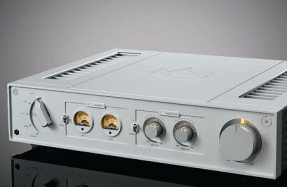
COPLAND CSA 150
Famous Danish manufacturer Copland has released the top-of-the-range integrated amplifier in its latest CSA series. The new CSA 150 is a hybrid design using a double triode gain stage (6922) with MOS-FET buffering. The solid-state bipolar output stage is rated with an output power of 150-watts per channel into 8Ω and 230-watts per channel into 4Ω. According to Aleksandar Maksimovic of Audio Magic, which distributes Copland in Australia the new amplifier will deliver higher power when reproducing music. “Under dynamic conditions the CSA 150’s current feedback power plant will deliver several times its rated power, more than enough to drive almost any loudspeaker,” he said.
The Copland CSA 150 has a built-in DAC that uses an ES9018 Reference 32-bit DAC to provide multiple S/PDIF inputs (one coaxial, two optical) plus a USB input and has both PCM and DSD capabilities. An optional aptX HD Bluetooth module can be fitted if a wireless capability is required.
For analogue use, the Copland CSA 150 has three unbalanced line inputs, two balanced line inputs and a phono input (MM). It also has a dedicated headphone output stage and balanced and unbalanced line-level outputs.
Copland rates the CSA 150 with a frequency response of 10Hz to 150kHz (-3dB) and a signal-to-noise ratio of ‘better than’ 90dB (IHF-A). Available now, the Copland CSA 150 sells for $8,400.
For more information, contact Audio Magic on (03) 9489 5122 or via its website at www.audiomagic.com.au
FIRST LARSEN IN AUSTRALIA
Larsen HiFi speakers are available for the first time in Australia from Melbourne-based distributor Nirvana Sound. Larsen is a Swedish manufacturer whose omni-directional (ortho-acoustic) loudspeaker designs can be traced back to the famous designs originally invented by Sonab of Sweden.
One of the first models to arrive is the flagship floor-standing Larsen 9, which is 300x930x378mm (WHD) and weighs 25.5kg. It has a rated sensitivity of 88dB-SPL and a rated nominal impedance of 40. As is usual with an omni-directional design, the Larsen 9 has three 25mm soft-dome tweeters (all made by Scan-Speak) each one of which fires in a different direction. An angled 174mm Scan-Speak Illuminator driver sits high on the very ‘Sonab-looking’ cabinet to deliver mid and low frequencies while lower down in the cabinet, a 197mm Scan-Speak Illuminator driver in a bass reflex enclosure delivers the lowest frequencies down to a claimed 22Hz.
The crossover network is very complex not only because of the 2.5-way design (where the 197mm driver is low-passed at 300Hz, and the 174mm driver crossed to main tweeter at 2.5kHz) but also because the ‘vertical’ tweeters are high-pass-filtered at 5kHz. The crossover components include large, air-wound copper inductors and Jensen foil capacitors.
It should be no surprise that Larsen speakers look like Sonab speakers, because when (1925-97), who founded Sonab, left it and went on to found Carlsson, he did so in partnership with . After Carlsson died in 1997 Larsen continued building Carlsson speakers until 2006 when he started up again in partnership with and designer (who tragically died in 2014 aged 34), this time using his own name to badge the speakers.






